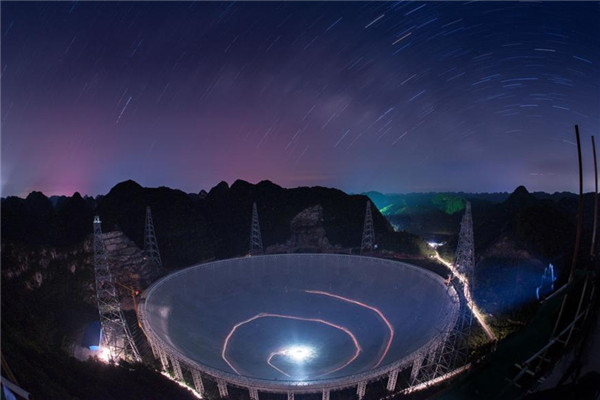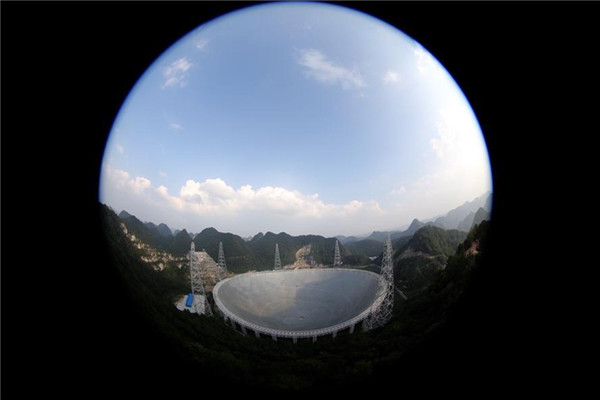
This scene shows the night view of the 500-meter Aperture Spherical Telescope in Pingtang county, Guizhou province, June 27, 2016. (Photo/Xinhua)

This scene taken from FAST's viewing platform shows the panorama of the 500-meter Aperture Spherical Telescope in Pingtang county, Guizhou province, Sept 24, 2016. (Photo/Xinhua)
Scientists of the world, attention please: You are invited by China to listen for alien life from the world's largest telescope it built.
With the massive facility officially beginning to operate on Sunday, leading scientists told China Daily that foreign scientists will be welcome to use China's gigantic Five-hundred-meter Aperture Spherical Telescope, known as FAST.
It is a single-aperture telescope the size of 30 soccer fields, located in Guizhou province in southwestern China.
The facility, surpassing the second- largest by 200 meters in diameter, is being called a game-changer in space research.
President Xi Jinping on Sunday sent a congratulatory letter to the scientists and engineers who contributed to its creation.
"The launch of FAST symbolizes a major breakthrough in China's science research and has great significance for the country's strategy to push forward innovation," Xi said in the letter.
FAST will search for gravitational waves, detect radio emissions from stars and galaxies, and listen for signs of intelligent extraterrestrial life, scientists said.
"The ultimate goal of FAST is to discover the laws of the development of the universe," said Qian Lei, an associate researcher with the National Astronomical Observation, part of the Chinese Academy of Sciences, which built the telescope.
"In theory, if there is civilization in outer space, the radio signal it sends will be similar to the signal we can receive when a radiation beam from a pulsar (spinning neutron star) is approaching us," Qian said.
Zhang Shuxin, deputy general manager of the project, said foreign scientists can start conducting their own space research at FAST once debugging is completed.
But before that is done, "we wouldn't feel very good" to start distributing time slots to foreign astronomers, he said.
"It's such a huge thing, you see," Zhang said. "And the technologies we use in both its driving device and reflecting surface are entirely new to us."
"As the first step, a parabola of 300 meters in diameter will be formed on the surface, with the help of the driving device, and start receiving signals," he explained. "We need to gather experience and develop methodology to ensure detection accuracy for that."
It may be three to five years before FAST can guarantee its best performance, Zhang said.


















































